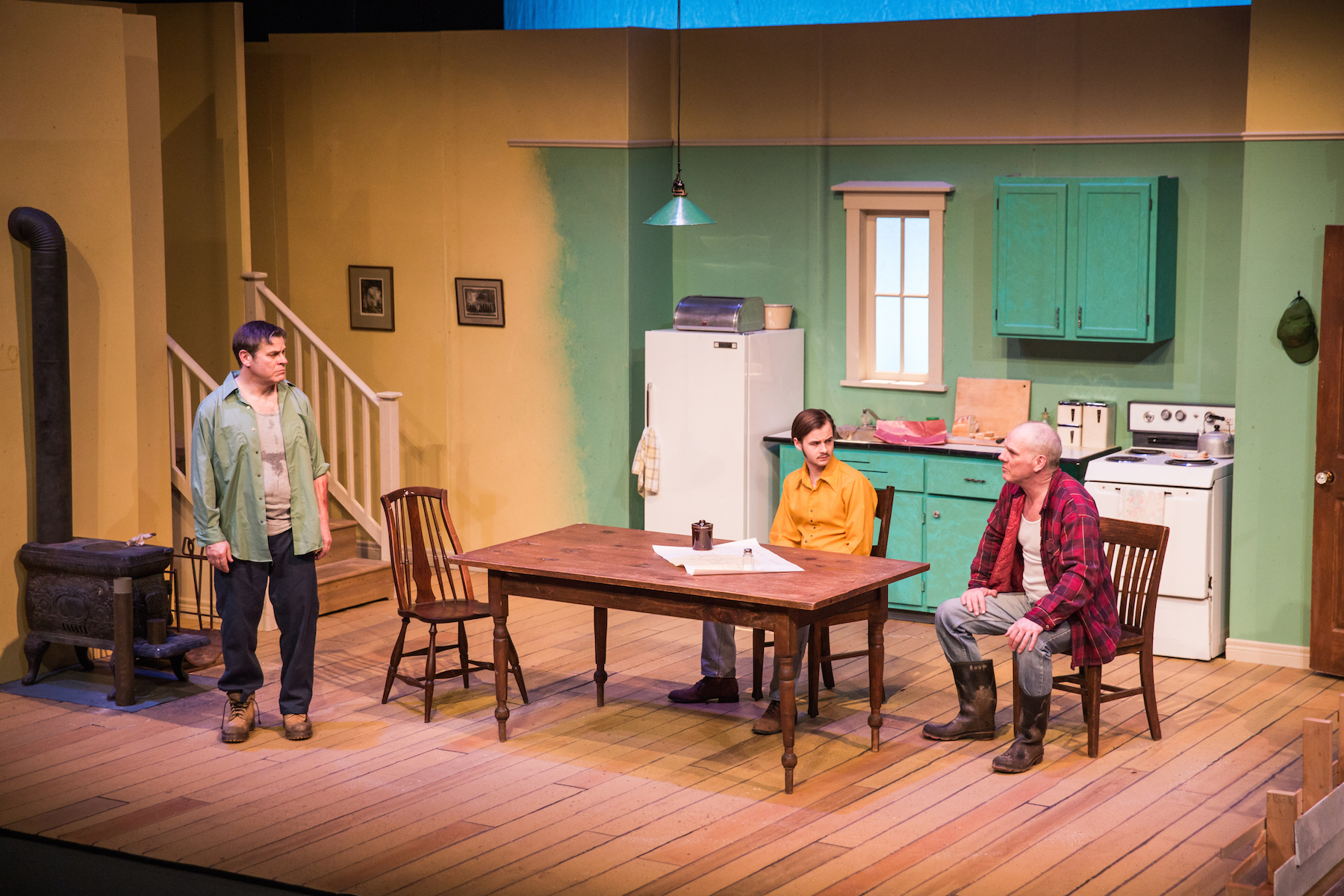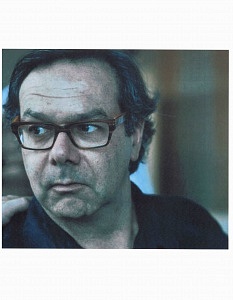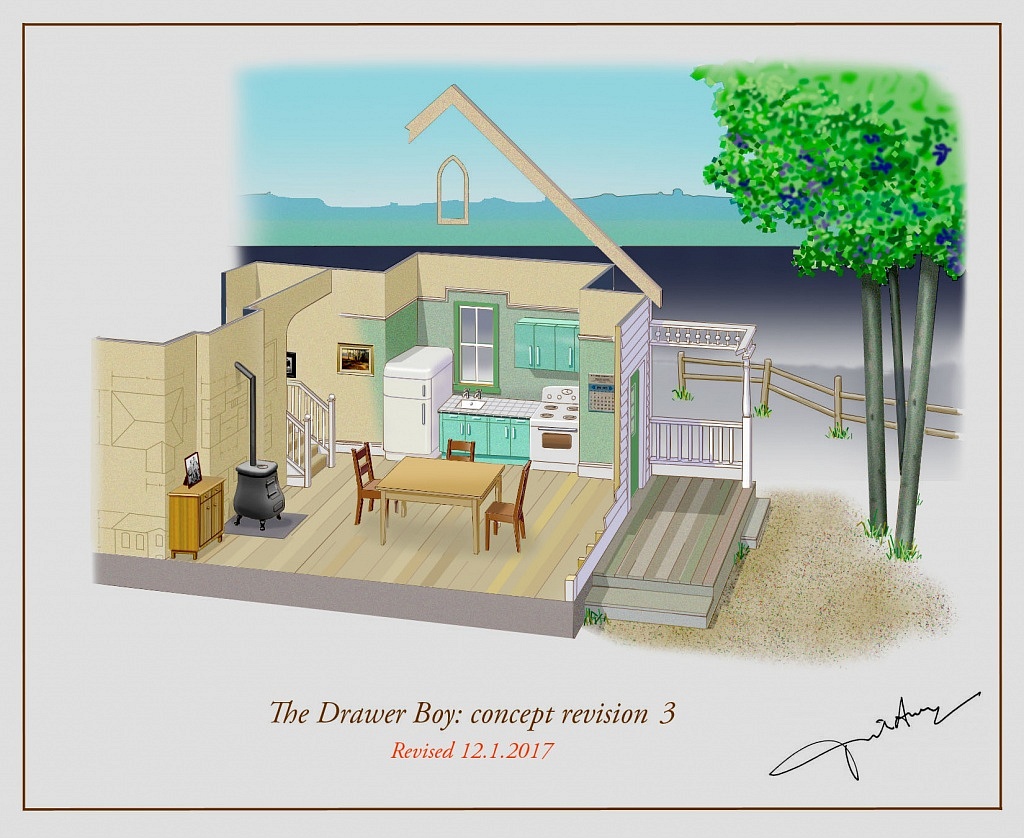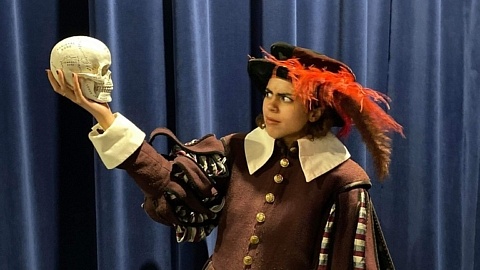It’s been a few weeks since the final performance of Brock University Department of Dramatic Arts’ Fall Mainstage, Scenes from an Execution. Closing off their...
On the fictional farm: Behind the scenes of ECT’s production of The Drawer Boy
February 22nd, 2017:
I entered Robertson Hall in the First Ontario Performing Arts Centre at 7pm as The Drawer Boy crew were adding last minute tweaks to the set. The space was set up in typical tech week fashion: a row of tables and chairs in front of the stage for designers and operators, adorned with switchboards, computers, cables and wires of all sorts, and the odd coffee cup (nectar of the gods during tech week). Designers Roberta Doylend (costume), Ethan Rising (sound), and Jacqueline Costa (lighting), along with Beatrice Campbell (stage manager) were all taking a short break before the tech run, having been at the theatre almost ten hours that day.
I had the chance to meet set designer David Antscherl who was helping the crew. The picture of his design that Monica had shown me upon my first visit had come to life before me. The attention to detail—rusted wood-burning stove, pictures hanging on the walls, and beautiful white birch trees stage left—was obvious, and had me awestruck. After Monica arrived at the half hour call, dresser Jo Pacinda went to fetch the actors who were warming up backstage.

Photo courtesy of Lauren Garbutt.
At fifteen minutes to top of show, the actors wandered the stage to get a feel for the space, opening cupboard doors, walking out onto the porch, and practicing going up and down stairs. Meanwhile the ops (technical operators), designers, and stage manager got into places, headsets on, pens and switchboards at the ready. A recording of Monica’s voice came on to signal the show was starting, instructing audience members to turn off their electronic devices. The house lights went down and the theatre faded away.
The music was the first thing that caught my attention. Throughout the show the combination of high energy violin/guitar jigs and soft, dreamlike sequences accompanied by piano set different moods. In the opening scene when Miles is waiting for Angus to ask Morgan if he can work on the farm (and Angus forgets Miles is waiting for him), the strum of the guitar sounds much like a clock ticking, adding to this comedic moment of waiting. The most striking moments are those of heightened tension, or when Angus makes a discovery—a suspenseful instrumental sound effect crescendoes to a lightbulb-like, aha-moment effect to emphasize its importance.

Photo courtesy of Lauren Garbutt.
I noticed a pattern in both the progression of costume changes as well as in complimentary colour patterns between characters. Miles’s costume at the top of the show—an overcoat, vest, button-up shirt, and striped pants, all in various yellow shades, as pictured above—stands out in his environment, but as the play progresses he ditches the sharp garb for farm-appropriate attire. Each character seems to have an identifying colour scheme: Angus wears varying shades of green and grey, Morgan compliments Angus in grey and blue, and Miles stands out in yellows, save for when he’s working on the farm. This use of colour emphasized character relationships for me and stood out against the teal/turquoise backdrop of the set walls, drawing attention right to the actors.
The ever-changing colour of the backdrop upstage of the set was a beautiful way to transition between different points in the day. This made passages of time more clear, and with the addition of various top lights in whites and blues, the ambience of more peaceful scenes was enhanced: When Miles and Angus look up at the stars, the light on them is soft but they still stand out against the night backdrop.
At the end of the run the designers, ops, Monica, Beatrice, and I all gave a round of applause for the actors and for a successful tech run. “Looks and sounds amazing, everyone,” Monica said as everyone broke into groups—while Monica spoke to the designers and ops, the actors went backstage to change out of costumes and wait for their notes. As I left the theatre and my last rehearsal, I was excited to watch the show from an audience perspective, not having my nose in a notebook and able to really take it all in. I’m now handing coverage over to my DARTcritics colleague Caroline Coon, who’s reviewing the show on opening night.
February 16th & 17th, 2017
Going into The Drawer Boy rehearsal this week was bittersweet, as this was the second to last rehearsal I would attend, and the last one before the team moves into tech. On this particularly sunny Thursday I set myself up in the rehearsal hall not knowing what to expect from the day. Having seen a full stumble-through but then out of the rehearsal loop for four days, I was itching to know what the cast and Monica, the director, had been working on. As I settled in, the group was just returning from a lunch break feeling energized and a bit giddy.

Landon Doak (Miles) in rehearsal.
Monica informed me that they had done a full run-through in the morning portion of rehearsal, so this portion would be devoted to ironing out the kinks and fine-tuning specific scenes. She decided to start with Act 1, Scene 4, to which Beatrice attributed the name “ouchy legs”—this refers to Miles’ entrance into the scene in which he (quite hilariously) walks onto the stage, visibly and audibly in pain, as a result of unloading hay bales with Morgan. This scene is one of my favourites for both the comedy—an example being Miles’ boisterous account of his work with Morgan—and because this is the first glimpse of a budding friendship between Miles and Angus. Though the relationship starts out rocky—Angus continually forgets who Miles is—this relationship goes to show that age has no limit when it comes to mutual respect, understanding, empathy, and camaraderie.
This scene was run quite a few times, Monica giving the actors new tactics or intentions to play with and explore (intentions refer to the driving force behind what the actors say and why they say it). At one point, she told Landon (Miles) to treat Tony (Angus) like he’s his little brother, teasing him to get a rise out of him—“go further than you think you need to,” she told him. It seemed like Monica was really pushing the actors to make new discoveries today—being so close to opening I can imagine that it becomes difficult as actors to continue finding new thoughts or intentions, so Monica challenges them by offering new perspectives.
Something I realized in watching this rehearsal was Morgan’s potential for tenderness and empathy. There are subtle nuances in Jack’s portrayal of the character that reveal Morgan’s soft side when it comes to caring for Angus—he uses a careful, low tone of voice when Angus becomes distressed, his eyes focused yet soft on his friend. Jack does well in setting up Morgan as a stone-faced, emotionally guarded person, only to subvert expectations through small tics or glimmers of compassion in his face and mannerisms.
Continued…

Director Monica Dufault.
I returned the next day, February 17th, to see a run-through; sound designer Ethan Rising was there to take notes. Before the run, Monica gave each actor a note to keep in mind. She wanted Jack to clock the places where Morgan opens up to and trusts Miles, and to think about what it would mean to lose Angus; Tony to explore variations in agitation during moments where Angus loses his temper; and Landon to focus on key moments in his character relationships—when he is connecting with and being accepted by Morgan and Angus, and when they push him away.
While it was difficult for me to keep track of these notes and clock for myself when the actors were implementing them, this run-through had a completely different energy than the stumble-through I witnessed a while back. There were things I hadn’t seen before (perhaps I’d not noticed them): in the moments when Miles or Morgan are talking to Angus and he doesn’t remember what’s going on, he reverts to habitual behaviours. Tony makes these shifts/moments clear in his body language and in the unsure nature of Angus’ response.
As another rehearsal came to a close it hit me that I only have one more embedding visit after this! I am to attend a tech/dress on February 22nd—the first time I will see the performance in its entirety with lighting, sound, costumes, and the set that I have only seen in picture form. It will be interesting and exciting to see how the performance translates into the performance space.
February 12th, 2017:
I arrived at the Suitcase in Point building on February 12th, excited to be back in the rehearsal hall, and curious to see the progress Monica and the cast had made since my last visit. After arriving and getting settled I learned that, after having rehearsed all of act one Friday February 10th and act two on the 11th, the cast would do their first full stumble-through. In a stumble-through the cast runs the whole show, for the most part, without stopping or interjection so the director and, in this case the designers, can observe and take notes. Compared to a regular run-through of a show, the stumble-through happens in the earlier process of the show when technical notes, blocking, and actor notes are still being made. The show’s costume designer Roberta Doylend and lighting designer Jacqueline Costa were in attendance that day—it was a pretty packed space with myself, the designers, Dufault, and Campbell sitting as far off stage as we could be.

Tony Munch (Angus) going over his lines in rehearsal
The actors seemed to be in the zone. Tony (Angus) was stretching, Jack (Morgan) running his lines, and Landon (Miles) warming up his vocal chords—as this went on Beatrice (SM) set up the space, placing all props and set pieces so they could be readily available to the actors when needed, and even stashing a jug of water in the “refrigerator” for them. Though outside was rainy-snowy chaos, it had little impact on the energy of the room—I and the others observing had pens at the ready, and when Campbell called “Cell phones off” followed by “Stand by. Lights” all eyes were on the playing space.
It’s refreshing when a rehearsal room is a space where actors and other theatre artists reserve the right to fail, and fail gloriously. There was no shortage of the stumble factor in this run, but because Monica and the cast have fostered a safe and open space for the occasional misstep, the support in the room is unwavering. At one point at the top of what was supposed to be act 1 scene 3, Tony accidentally jumped to the scene after, walking out on stage to begin, which had a hilarious jarring affect on the other two actors. This and intermission were the only times Beatrice and Monica stopped the run, but everyone found the flub quite funny and quickly got back on track.
The addition of a wood dining table and other small kitchen props like a sugar bowl made the space more homey and warm. Tony entered the space for act 1 scene 4 (at the right time), his eyes scanning over the room, taking in the space—he looked to be right at home. Something the actors do really well is helping me suspend my disbelief about their surroundings. Whether it’s a black box, bare-stage performance or an extravagant and detailed stage full of set pieces, as a theatregoer I place responsibility on the actor to transport me into their world, and these three actors do just that. An example is Angus’ recurrent wandering around the kitchen throughout the play—Tony dreamily walks from one end of the stage to another, touching the wall as if something is missing there. He scans the floor, the ceiling, even checks inside the cupboards. This feeling of something missing is well established by Tony, not only giving me a sense of the world but a sense of Angus’ internal conflict. Did something used to hang on the wall? Is Angus regaining his memory, or is he just trying re-familiarize himself with his home, fearing it may fade from his mind? For the moment, that’s for me as an embedded critic to know and you, the reader, to find out!

J.D Nicholsen (Morgan) and Tony Munch (Angus) rehearsing
This rehearsal was different from the one previous in that Monica didn’t give the actors notes during the run—I sat remembering the notes she had given at the last rehearsal and noting what new discoveries were made. One thing that stood out was that the comedy was a lot clearer than before. In my view, the comedy in this show doesn’t so much come from the writing but from the line delivery and honesty of the actors’ intentions. Prior to this run I hadn’t realized what a funny character Miles could be. Landon took moments of ridiculousness such as performing a monologue as Daisy the cow, or discussing his idea for a dance number devoted to the hay bale stacker, and infused them with earnest and believable truth—these moments had me and the rest of the on-lookers cracking up.
At the end of the run we all gave the actors a much deserved round of applause; soon after Monica, Beatrice, Roberta, and Jacqueline headed to a production meeting while the actors broke for lunch. Having had the opportunity to view a full run it will be interesting to see, in the next rehearsals leading up to tech, what more Monica and the cast can do with this play. As I observed Monica scrawling notes throughout the run, I anticipate there is still work to be done, but from where I sat in that rehearsal hall, I was in awe of the progress that had been made since my last visit and am looking forward to where they will take this production.

Michael Healey, author of The Drawer Boy
February 7th 2017: On the chilly, grey afternoon of Tuesday February 7th I ran into Essential Collective Theatre’s artistic director Monica Dufault outside of the Suitcase in Point Theatre Company building (36 James Street). I was there to attend a rehearsal of Michael Healey’s play The Drawer Boy, which Dufault is directing. I am following the show as an embedded critic, meaning that I’m attending some rehearsals and writing about them, in the interest of informing you, the readers, about the process, as well as assessing this creative work and creating a dialogue between the artist, the critic, and the community. Having previously embedded in ECT’s production of Poor back in February of 2016, I am excited to have the opportunity to bring to you insight into what goes into a production from conception to performance.
Having met Dufault—perfect timing!—we headed up together to the third floor where the rehearsal was to take place. The modest rehearsal hall, with its pale blue grey walls, vintage style heat radiators, and simple charm was set up like a kitchen. A long table downstage right I could only assume was the dining table; three tables lining the upstage area represented kitchen cupboards, a fridge, and a stove; and lots of stage tape mapped the imaginary boundaries of the set. In a meeting prior to this rehearsal, Dufault had shown me a diagram of the beautiful 1970s style farmhouse set (deigned by David Antscherl), so it wasn’t hard for me to suspend my disbelief. The group had only begun rehearsing near the end of January/beginning of February, and today they were already starting to work on the second act.
Having read The Drawer Boy, I sat in my seat with excited anticipation, wondering what Dufault and her cast of three talented actors would bring to a play that, while comedic and lighthearted for the most part, deals with questions of morality and some harsh truths. Set in 1972 on a small farm in Clinton, Ontario, it opens with the arrival of Miles (Landon Doak), a young actor from Toronto who has come with an acting troupe to work for and study farmers, with the intent of creating a play about them. Miles arrives in the front yard of friends Angus (Tony Munch) and Morgan (J.D Nicholsen)—the two are a couple of bachelor farmers whose years of friendship span from being high school buddies, to touring together as soldiers during World War II, to Angus’ almost fatal head injury in London, resulting in short term memory loss.
All of this leads up to their lives together, tending their crops and making a living off the land. What starts as a simple offer from Miles to work on the farm for free quickly turns into something more complicated when Miles overhears Morgan telling Angus a story—from that moment onward, as pieces of the story begin to affect each of the characters, the audience is ultimately lead question what’s true and what’s not.
Upon reading the script I was captivated by the bond shared between Angus and Morgan who share a friendship that goes beyond enjoying each others’ company—one of survival, mutual dependance, and unwavering support. Though Angus struggles with his short-term memory, the manner in which Morgan speaks to him is never condescending or patronizing, as one might speak to a child—he is patient, kind, and stern when he needs to be. Speaking of support, it was clear that from the moment I entered the room and observed Dufault’s interactions with the actors, that this is a cohesive group that all share a passion for this production. The atmosphere of the rehearsal room was light-hearted and easygoing—Dufault introduced me to the cast and to stage manager Beatrice Campbell, who were all welcoming and positive about my being there.
After the the actors welcomed each other back to another rehearsal, Dufault called them together to begin with Act 2, Scene 1. As they began, it was clear to me that a significant amount of work had gone into the rehearsals prior to my attendance that day. The scene they were working on is full of character discovery, tension, and high stakes—Angus makes an important discovery about his past that Morgan, up until now, has been keeping from him. As I previously mentioned the group are still in the early rehearsal stage, so I was pleasantly surprised to watch the actors engage with their characters and relationships so intimately. There were times throughout where “line” had to be called, but they remained focused and channeled all their energy into the gravity of this scene. At one point, Dufault stopped the actors near the end of a scene, giving a few technical blocking notes and apologizing for starting the scene hastily without having sufficiently taken account of its intensity. I could understand where she was coming from—how a scene of this emotional/mental weight could need some build-up or prep work prior to diving in.
At times, blocking proved to be a bit of an issue—the rehearsal room is significantly smaller than the actual set will be, so certain configurations had the actors feeling confined behind a table or struggling to maneuver around their fellow cast members. These situations were often rectified as Dufault would take input from the actors, as when Munch gave her a suggestion on a path to get his character heading in the direction of the porch without bumping into or blocking Nicholsen.
It was refreshing to watch Dufault communicate with the actors—whenever she would give blocking notes or notes on specific intentions that she wanted to see them play with, she would get up from her seat and enter the playing space as opposed to giving the directions from her chair. As an acting student I appreciate this approach because it shows that the director wants the actors to feel that she is present with them. There was a considerable amount of stopping, starting, and re-working but Dufault kept it fresh by suggesting new actions and thoughts for the actors. At one point she told Munch to find the fun in the part of a scene where Angus has a flashback to a specific point in his youth, reliving the memory as if it were occurring in the present situation; Dufault encouraged Munch to play this with giddiness and excitement of a young man.
Monica pushed Doak later on in the run, in a scene where Angus makes a connection between Morgan’s story and his own past life and becomes erratic and emotional, calling for Morgan, who does not answer. Dufault posed the question to Doak: how far would Miles go to help Angus? She had the actor think about whether Miles would go so far as to strike Morgan, maybe grab him and shake some sense into him, to get him to see how tortured Angus is. Doak took this note and ran with it: the urgency behind the intention really came through and I could see the intensity and clarity of his thought process.
After a few more runs of the scene Dufault took a breath and asked the actors if they wanted to let that scene go now and move on, and it seemed clear that all felt good about the work they had accomplished. With that she released the actors for a short break and I packed up my notebook, still feeling the emotional impact of the scene, but also feeling excited to attend future rehearsals.
I was left with a couple of questions bouncing around in my head: How will the move from the rehearsal to performance space affect the production? In dealing with some of the heavier content of the show, how do the actors stay grounded and not internalize the heavy emotions and themes? What has been Monica’s experience directing three actors who she’s never worked with before? I anticipate that these answers will come in the next rehearsals I attend, as the process of embedding is all about making discoveries, asking questions, and unpacking the answers.
Related Posts
Here’s Holly Hebert’s final solo vlog from behind the scenes of the Fall 2020 DART Mainstage, Scenes from an Execution. She and Asenia will round off this...
Scenes from an Execution has opened, and even as someone working on it I was floored by how well the ambitious design turned out and how far the actors have...
Here’s Holly Hebert’s final solo vlog from behind the scenes of the Fall 2020 DART Mainstage, Scenes from an Execution. She and Asenia will round off this...
Scenes from an Execution has opened, and even as someone working on it I was floored by how well the ambitious design turned out and how far the actors have...
Leave a Reply (Cancel Reply)
Twitter Feed
Blogroll
DARTcritics.com is partially funded by the Marilyn I. Walker School of Fine and Performing Arts, in support of student learning; experiential education; student professionalization; public engagement with the teaching, learning and production activities of the Department of Dramatic Arts; new ways of thinking; and the nurturing of links with our communities.









